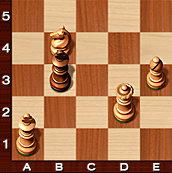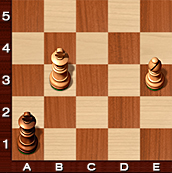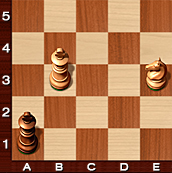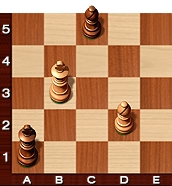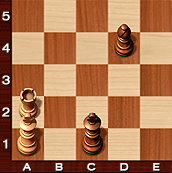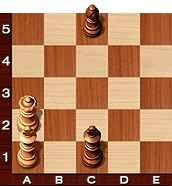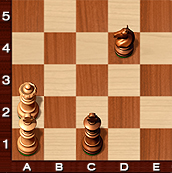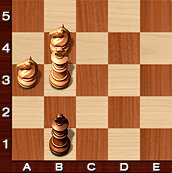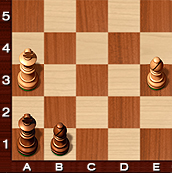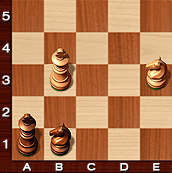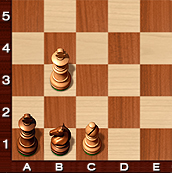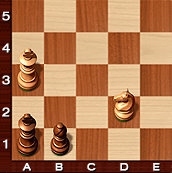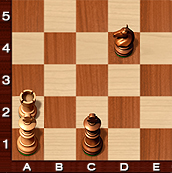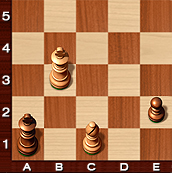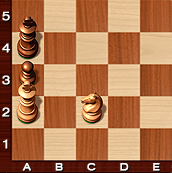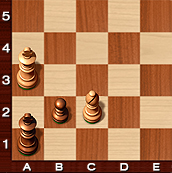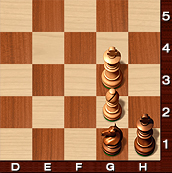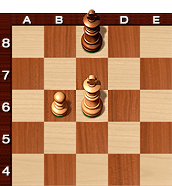Draw Cases
|
Case B) A player uses all of his or her time and loses the game, despite the fact that at first sight his or her opponent appears to have insufficient material to deliver checkmate. |
Case A)
A PLAYER RUNS OUT OF TIME, BUT NEVERTHELESS THE GAME IS A DRAW
Usually, a player who uses all of his or her playing time loses the game, regardless of the position. However, there are exceptions where the game ends in a DRAW.
All our site rules regarding Case A drawn games are in keeping with the FIDE Laws of Chess (2009 art. 9.6, which regard games where a player has used all of his or her playing time, but his or her opponent cannot force checkmate).
It is important to note that in cases below, the player who still has time on his clock CANNOT FORCE CHECKMATE EVEN IF HIS OR HER OPPONENT WERE TO COOPERATE BY PLAYING THE WORST POSSIBLE MOVES.
|
1) THE KING IS THE ONLY REMAINING PIECE If the player with time remaining has no other piece but the king (easily the most frequent case), the game is a draw Therefore, in the example to the right, if White has used all of his or her playing time, the result is a draw. Obviously, if both players have only their kings remaining, it is an automatic draw. |
|
|
2) KING and BISHOP vs. KING When one player has a king and bishop, and the other has just the king, it is impossible for either player to checkmate.
|
|
|
3) KING and KNIGHT vs. KING
|
|
|
4) KING AND BISHOP vs. KING AND BISHOP OF THE SAME COLOUR
|
|
|
5) KING AND BISHOP vs. KING AND ROOK
Naturally, this case is a draw only if the player with the rook runs out of time |
|
|
6) KING and BISHOP vs. KING and QUEEN
|
|
|
7) KING and KNIGHT vs. KING and QUEEN
It is possible for a king and knight to deliver checkmate when an opponent has only king and rook, but not if he or she has king and queen.
Even in the position most favourable for Black, seen in the example to the right, after 1…Nc2+ , White draws the game by giving up his or her queen with Qxc2.
This case is a draw only if the player with king and queen runs out of time. |
|
Case B)
A THEORETICAL DRAW, BUT NOT IN PRACTICE!
A player uses all of his or her time and loses the game, despite the fact that at first sight his or her
opponent appears to have insufficient material to deliver checkmate.
FIDE regulations state that blitz games are not considered to be a draw just because a theoretically drawn position has been reached (see below). The reasoning behind this is that with the short period of thinking time available in these time controls, it is much more likely that players will make mistakes, instead of playing the best moves required to achieve a draw. In short, theory is of little practical relevance in the chaotic world of blitz chess.
Indeed, FIDE Laws of Chess prohibit a draw claim being made during blitz games (FIDE Laws of Chess, appendix B.(3) Blitz states that article 10.2, which prescribes the right to claim a draw, does not apply to blitz games).
We again remind you that "The game is drawn when a position is reached from which a checkmate cannot occur by any possible series of legal moves" (FIDE Laws of Chess art. 9.6), which is the rule that is applied on this site. The only exceptions to this rule regard some very rare positions that are completely closed or blocked. This is because there is not enough time for the automatic system to analyze such positions at sufficient depth to realise that checkmate is impossible.
|
8) King vs. king and 2 knights is a theoretical draw, but the correct defending king moves require precision.
On the other hand, if White is the one who runs out of time, the game is declared a draw as Black has only the king. (see Case 1 above). |
|
|
9) Case 4 is the drawn position where both players have a king and bishop of the same colour. With that material balance it is impossible to win regardless of what moves are played. However, it is different when each player has a single opposite-coloured bishop, as a mistake by either player can result in checkmate.
Black has just blundered with 1…Bb1??, allowing White to mate with 2. Bd4.
|
|
|
10) Also with king and knight vs. king and knight it is possible for either player to checkmate an opponent who makes a mistake:
in the example on the right, Black blunders with
|
|
|
11) King and bishop vs. king and knight is another example of where it is possible to win: Here, Black has played the disastrous 1…Nb1??, allowing White to win the game with 2.Bb2, checkmate.
12) The above also applies to king and knight vs. king and bishop: in the example to the right, White has the move and can checkmate with 1.Nb3.
|
|
|
13) With king and knight vs. king and rook, checkmate is also on the cards. In this example, White has just played 1.Ra2??, allowing 2.... Nb3, checkmate.
|
|
OTHER CASES
It is important to examine some other cases that frequently cause confusion:
|
14) In this case, if White runs out of time, Black wins (given that the pawn will soon promote to a queen, with an easy victory).
|
|
|
Gambling on a time advantage! 15) In the example position, if White captures the pawn the game is an automatic draw (see Case 3 above). However, if White has a time advantage, he has the right to try to win the game on time.Instead of taking the pawn, White can just make a series of moves in the hope that Black will run out of time. However, White must be careful that the same position is not repeated three times with the same player to move, as this results in an automatic draw.
|
|
|
16) Also here the first player to run out of time loses! Black cannot expect a draw because White has only king and bishop, as it is still possible for White to win! How?
17) By promoting the pawn to a knight (the only promotion choice that loses: all other promotion options create the draw cases given at the beginning). Now there is the same possibility given in Case 11: Black could make the mistake of moving his or her king to h1 and the knight to g1, allowing Bg2, checkmate. |
|
|
18) In this position we have a noteworthy example ofmutual zugzwang. If it is Black to move, White will win; if it is White’s move, we have a draw. Given that 1.b7+ Kb8 immediately produces a draw (2.Kb6 is stalemate, and other moves result in the loss of the pawn), White could try to win on time with the moves 1.Kc5 or 1.Kb5.
|
|
It is not bad sportsmanship to win on time!
Time management is a fundamental chess skill for all time controls; needless to say, this is particularly the case for blitz games (not to mention bullet, where time management is usually far more important than finding best moves!). Remember that a player constantly has to balance quality of play against time available, and accept the resulting benefits and risks associated with playing too slowly or too quickly.
Players with little competition experience sometimes feel that is unsporting to try to win on time when the position is clearly drawn (or lost!). Nothing could be further from the truth. It is perfectly normal to use your time advantage in this way and it permitted by the regulations.
Players who prefer games where time management is less of a factor, should consider challenge matches played with an incremented time control (i.e. every time a move is made, extra time is added). Such time controls (e.g. 3 minutes + a 3 second increment per move, instead of 5 minutes without increment) make it much less likely a player will lose a drawn position on time. Though there is sometimes a little less adrenalin when there is a time increment, this might be the right choice for players who prefer never to be left with virtually no time to think.
